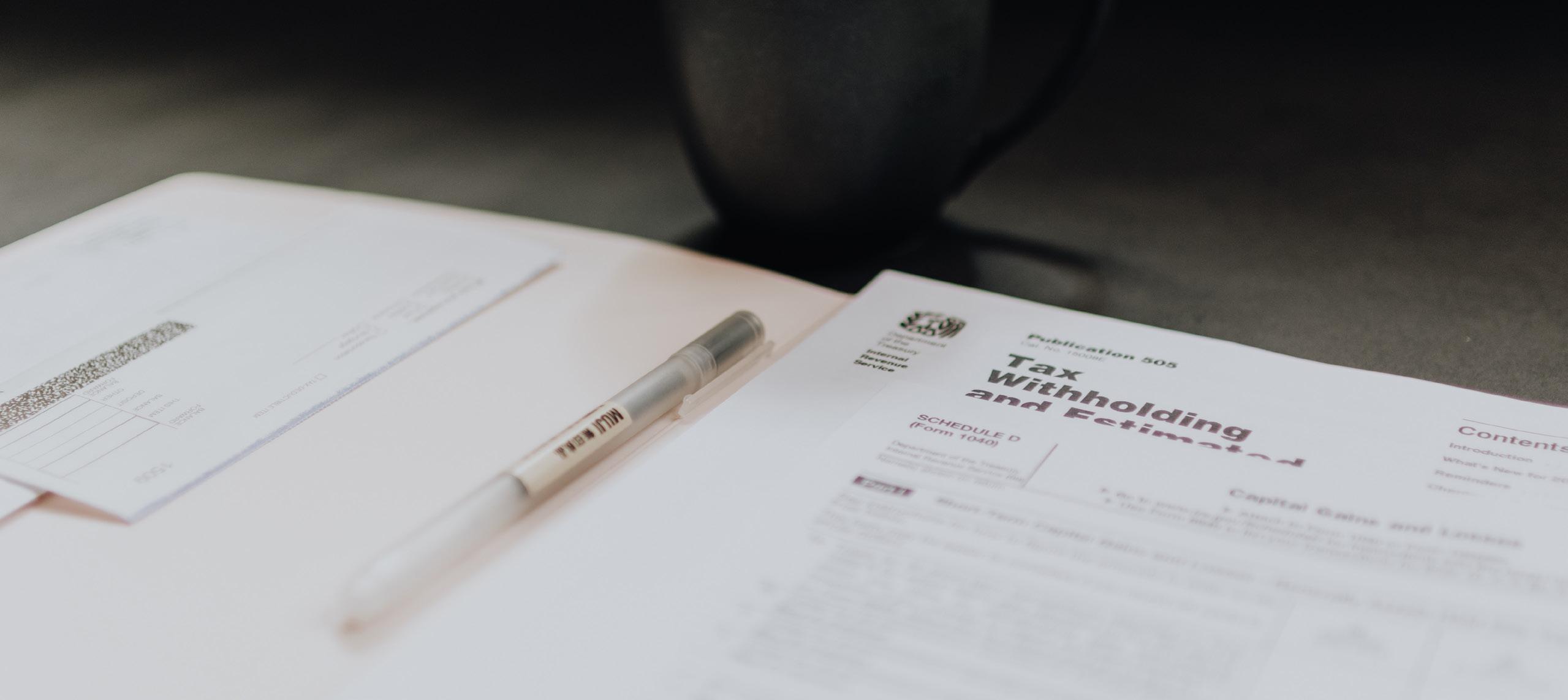The Captain’s Log Winter 2022
WIDE Open Spaces
Ginger and I traveled to Yellowstone National Park during the Fall of 2022 for a quick fly fishing and sightseeing adventure, and for anyone who has not lived the experiences of Yellowstone, I can only emphasize that words will never properly relay the unimaginable beauty of one of the most iconic places on Earth. Yellowstone’s magnetic draw lives in the remarkable diversity of the land; the towering waterfalls, pristine valleys, and seismic uprising which all coexist within mere miles of each other. The Park is both stunning and limitless in its appeal to the human mind.
In some strange correlation, while pondering our 2022 investment market’s experiences, I fall back to my Yellowstone adventure. On the surface, the beauty and confidence of the 2022 investment markets appeared welcoming and inviting, but below the crust the


geological instability boiled, bubbled, and threatened anyone who dared his luck. How can a place so beautiful and so welcoming perfectly camouflage something as dangerous and deadly?
As investors, we tolerate stock market volatility because we have been conditioned to accept the irrational quantitative and algorithmic day trading cycles as the necessary pain needed to participate in long-term asset value appreciation. We know intuitively that short-term drawdowns create longterm opportunities. It is never fun to live through these cycles, but we have faith in the process, and we refuse to capitulate our belief in the American capitalist system.
The unexpected turbulence of 2022 came from the hibernating Grizzly – the bond market. This normally
(continued on page 3)


Federal Reserve tightening.
benign, slumbering giant awoke this past year and rattled the nerves of economic markets across the globe. The 40-year bull market for Bonds came to a collapsing halt and as quickly as Old Faithful blows her steam, the bond market repriced downward in an immediate reaction to the Federal Reserve’s inflationary response. The bear market for bonds was alive and it announced its presence as loudly as a pack of grey wolves attacking a herd of sleeping sheep. Like the bridges across the North side of Yellowstone, in the blink of an eye, our investment safe havens collapsed, and we as income investors were left stranded in a dark wilderness of confusion and unpredictability.
With eyes glazed over, we now turn towards the New Year staring into the uncertainty of 2023 desperately trying to identify the green shoots of life within the patchwork of a fire riddled forests. We know when the land is scorched opportunity will germinate, and it our responsibility as investors to seek out the hidden pockets of mispriced assets. Success in our business comes with the understanding that time exists as the ointment for all scares. As the days and months slowly slip away, so does the threat of economic uncertainty and so does the spasmatic and over-reactive jolt of
I believe 2023 has the potential to reward us all for our patience and persistence as investors. The burning fire of inflation seems to be extinguished and the Federal Reserve, with dissension on the Board, appears to be migrating to a more dovish stance in their positioning on economic tightening. Coupled with an attractive corporate earnings growth forecast and currently compressed price to earnings ratios, the coming year promises to return us to our long-term financial growth expectations and a more normal trading volatility range.
I hope everyone has a wonderful Holiday Season, a fantastic New Year’s Celebration, and sprints into 2023 happy, healthy, and joyful for the year ahead. Let’s make time for each other and let’s keep marching confidently forward towards our long-term goals ignoring the wolves that try desperately to derail our conviction in The Process.
 AAMS Managing Director
AAMS Managing Director
A SOLDIER'S HANDS
What would you do if a soldier sitting next to you on a plane said "Thank you for the hand cream. Dry hands are harder to handle than my fear. Thanks for the offer to send some more over to me where I'm deployed, but truthfully, unless the whole unit gets some, it's not fair."
Well- one woman did have this conversation with a service member and decided to respond in 2007. Since then, A Soldier's Hands has distributed over 6,400 individual care packages, unit by unit, with no soldier or sailor in the unit going unacknowledged.

Our mission is to send hand care products inside a care package to every single service man and woman who is deployed defending our freedom. We achieve this one unit at a time, with personalized thank you notes in each care package, along with sunscreen, hand cream, lip balm and other surprises.
Prospera Financial, LLC and Jamestowne Investments, LLC support this mission.

A Soldier's Hands 2277 Oak Leaf Drive, State College, PA 16803

In October, during this year's annual Prospera Financial Advisors Conference, we were greeted by the most wonderful woman wheeling a load of hygiene products into our hotel conference room. She had the most contagious smile on her face and Ginger asked if she needed help. She proclaimed that Prospera and its Advisors had already helped so much but that she was there for our team of
Prospera employees and Advisors to help assemble gift bags to be sent to the troops overseas. In a about 20 minutes we put together enough care packages for 300 folks overseas and had raised over $7,000 towards more care packages in the future! The old adage of many hands makes light work really came to fruition on this day in Dallas.

The Anatomy of an Index

Did you know that an estimated $13.5 trillion in assets are indexed or benchmarked to the Standard & Poor's 500 Composite Index, including $5.4 trillion in index assets?1,2
The S&P 500 is ubiquitous – we see it on the news, read about it in the newspapers, and very likely, see some of our own investments' performance compared against it. For an index that represents approximately 80% of the value of the U.S. equity market, it may be worthwhile to gain a better understanding of how it works.1
Cap & Criteria
The index, as we know it today, was introduced in 1957 and is maintained by the Standard & Poor's Index Committee. Contrary to popular belief, it is not comprised of the 500 largest companies in America, but is a collection of large-cap stocks representing a broad range of market sectors, including technology, energy, health care, and consumer staples, among others.3
There are a number of criteria a company must meet to be considered for inclusion in the index. Some of these criteria include the following: it must be a U.S. company, have an unadjusted market capitalization of $14.6 billion or more, have 50% of its stock available to the public, and have four consecutive quarters of positive earnings.3
Changes Over Time
Another common misconception is that the index is a static one. In fact, companies will be removed, from time to time, for reasons that include violation of one or more of the criteria used for adding companies or because of a merger, acquisition, or significant restructuring, including bankruptcy.
The turnover in the index's constituent companies was 3.6% in 2020 (per the most recent data available). According to one projection, the average tenure of companies in the index is expected to fall to 15-20 years this decade, as compared to the 30-35 year average tenure in the late 1970s.4
Add and Subtract
When changes are made to the index, many mutual funds and exchange-traded funds that seek to replicate the index may have to sell stocks that are being removed and buy the stocks that are being added in order to track the index. Keep in mind that amounts in mutual funds and ETFs are subject to fluctuation in value and market risk. Shares, when redeemed, may be worth more or less than their original cost.5
Mutual funds and exchange-traded funds are sold only by prospectus. Please consider the charges, risks, expenses, and investment objectives carefully before investing. A prospectus containing this and other information about the investment company can be obtained from your financial professional. Read it carefully before you invest or send money.

Investors cannot invest in an index. Also, index performance is not indicative of the past performance of a particular investment, and past performance does not guarantee future results. Investment choices designed to replicate any index may not perfectly track it, and their returns will be reduced by fees and expenses.
1. US.Spindices.com, May 31, 2022
2. The S&P 500 Composite index (total return) is an unmanaged index that is generally considered representative of the U.S. stock market. Index performance is not indicative of the past performance of a particular investment. Past performance does not guarantee future results.
3. Investopedia.com, 2022
4. Innosight, 2021
5. Keep in mind that the return and principal value of stock prices will fluctuate as market conditions change. And shares, when sold, may be worth more or less than their original cost.
A Living Trust Primer
A living trust is a popular consideration in many estate strategy conversations, but its appropriateness will depend upon your individual needs and objectives.
What is a Living Trust?
A living trust is created while you are alive and funded with the assets you choose to transfer into it. The trustee (typically, you) has full power to manage these assets. But using a trust involves a complex set of tax rules and regulations. Before moving forward with a trust, consider working with a professional who is familiar with the rules and regulations.
A living trust will also designate a beneficiary, or beneficiaries, much like a will, to whom the assets are structured to automatically pass upon your death.
If you create a revocable living trust, you may change the terms of the trust, the trustee, and the beneficiaries at any time. You can also terminate the trust altogether.
Why Create a Living Trust?

The living trust offers a number of potential benefits, including:
• Avoid Probate - Assets are designed to transfer outside the probate process, providing a seamless, private transfer of assets.
• Manage Your Affairs - A living trust can be a mechanism for caring for you and your property in the event of your physical or mental disability, provided that you have adequately funded it and named a trustworthy trustee or alternative trustee.
• Ease and Simplicity - It is a simple matter for a qualified lawyer to create a living trust tailored to your specific objectives. Should circumstances change, it is also a straightforward task to change the trust’s provisions.
• Avoid Will Contests - Assets passing via a living trust may be less susceptible to the sort of challenge you might see with a will transfer.
The Drawbacks of a Living Trust
Living trusts are not an estate panacea. They won’t accomplish some potentially important objectives, including:
• A living trust is not designed to protect assets from creditors. It is also considered a “countable resource” when determining your Medicaid eligibility.
• There is a cost associated with setting up a revocable living trust.

• Not all assets are easily transferred to a living trust. For example, if you transfer ownership of a car, you may have difficulty obtaining insurance, since you are no longer the owner.
• A living trust is not a mechanism to save on taxes, now or at your death.
The information in this material is not intended as tax or legal advice. It may not be used for the purpose of avoiding any federal tax penalties. Please consult legal or tax professionals for specific information regarding your individual situation.


Systematic Withdrawls in Retirement
Many of us grew up with the concept that making regular, periodic contributions to our retirement account was a sound investment strategy. The idea was that, in a fluctuating market, regularly investing a set amount would enable an individual to buy more shares when prices were low and fewer shares when prices were high.1
Does this mean that taking regular, periodic withdrawals during retirement makes similar good sense?
Actually, it can be quite problematic.
Systematic withdrawals do the precise opposite of systematic investments by selling fewer shares when the price is high and more shares when the price is low. This, in effect, reduces the number of shares that may be able to participate in any subsequent market recovery.
Here's an example.
In the accumulation phase, if a portfolio falls by 25%, it will require approximately a 33% return to get back to its pre-decline value.²
In the distribution phase, if you withdraw 5% of your portfolio for income and suffer the same 25% market decline, you would need to see a 43% market rebound to get back to pre-decline value.²
Sequence of Returns
In the accumulation phase, investors tend to focus on average annual rates of return and less on the sequence of the returns. If you're a buy-and-hold investor, ignoring short-term fluctuations may be a sound long-term approach.

If you are in retirement, however, you absolutely care about the sequence of the annual returns.
For instance, comparable portfolios might deliver the same average annual return over a 20- or 30-year period, but they could have radically different outcomes in terms of account balance and income production. Generally speaking, negative returns in the early years of your retirement can potentially reduce how long your assets can be expected to last.
American writer H.L. Mencken once remarked that "For every complex problem, there is an answer that is clear, simple, and wrong."
Anticipating a lifetime of withdrawals from a defined asset pool over an indefinite period of time is a complex challenge for which there is no simple solution. Pursuing this challenge can require creative approaches and persistent vigilance.
1. Dollar-cost averaging does not protect against a loss in a declining market or guarantee a profit in a rising market. Dollar-cost averaging is the process of investing a fixed amount of money in an investment vehicle at regular intervals, usually monthly, for an extended period of time regardless of price. Investors should evaluate their financial ability to continue making purchases through periods of declining and rising prices. The return and principal value of stock prices will fluctuate as market conditions change. Shares, when sold, may be worth more or less than their original cost. 2. This is a hypothetical example used for illustrative purposes only. It is not representative of any specific investment or combination of investments.
Five Most Overlooked Tax Deductions
While few may raise their hands, Americans regularly overpay because they fail to take tax deductions for which they are eligible. Let's take a quick look at the five most overlooked opportunities to manage your tax bill.

1. Reinvested Dividends: When your mutual fund pays you a dividend or capital gains distribution, that income is a taxable event (unless the fund is held in a tax-deferred account, like an IRA). If you're like most fund owners, you reinvest these payments in additional shares of the fund. The tax trap lurks when you sell your mutual fund. If you fail to add the reinvested amounts back into the investment's cost basis, it can result in double taxation of those dividends.1 Mutual funds are sold only by prospectus. Please consider the charges, risks, expenses, and investment objectives carefully before investing. A prospectus containing this and other information about the investment company can be obtained from your financial professional. Read it carefully before you invest or send money.

2. Out-of-Pocket Charity: It's not just cash donations that are deductible. If you donate goods or use your personal car for charitable work, these are potential tax deductions. Just be sure to get a receipt for any amount over $250.2
3. State Taxes: Did you owe state taxes when you filed your previous year's tax returns? If you did, don't forget to include this payment as a tax deduction on your current year's tax return. There is currently a $10,000 cap on the state and local tax deduction.3
4. Medicare Premiums: If you are self-employed (and not covered by an employer plan or your spouse's plan), you may be eligible to deduct premiums paid for Medicare Parts B and D, Medigap insurance, and Medicare Advantage Plan. This deduction is available regardless of whether you itemize deductions or not.4
5. Income in Respect of a Decedent: If you've inherited an IRA or pension, you may be able to deduct any estate tax paid by the IRA owner from the taxes due on the withdrawals you take from the inherited account.5
1. TheBalance.com, 2021
2. IRS.gov, 2022
3. IRS. gov, 2022
4. IRS. gov, 2022
5. IRS.gov, 2022. In most circumstances, once you reach age 72, you must begin taking required minimum distributions from a Traditional Individual Retirement Account (IRA). Withdrawals from Traditional IRAs are taxed as ordinary income and, if taken before age 59½, may be subject to a 10% federal income tax penalty. You may continue to contribute to a Traditional IRA past age 70½ as long as you meet the earned-income requirement.
Who among us wants to pay the IRS more taxes than we have to?
Managing the Risk of Outliving Your Money

"What is your greatest retirement fear?"
If you ask some pre-retirees this question, "outliving my money" may be one of the top answers. In fact, 42% of workers say they fear outliving their savings and investments.1
Retirees face greater "longevity risk" today.
The Census Bureau says that Americans typically retire around age 63 for women and 65 for men. Social Security projects that today's 63-year-olds will live into their mid-eighties, on average. This is a mean life expectancy, so while some of these seniors may pass away earlier, others may live past 90 or 100.2,3
If your retirement lasts 20, 30, or even 40 years, how well do you think your retirement savings will hold up? What financial steps could you take in your retirement to try and prevent those savings from eroding? As you think ahead, consider the following possibilities and realities.

How will Social Security work in the future?
For decades, Social Security took in more dollars per year than it paid out. That ongoing surplus - also known as the Social Security Trust Fund – may face funding challenges as early as 2034. Congress may act to address this financing issue before then, but the worry is that future retirees could get slightly less back from Social Security than they put in. It's critical that pre-retirees estimate the amount of Social Security benefits they are expected to generate in the future.4
Preparing for out-of-pocket health care costs.
You can enroll in Medicare at age 65, but how do you handle the premiums for private health insurance if you retire before then? Striving to work until you are eligible for Medicare makes economic sense and so does setting aside money to pay for health care costs. A healthy couple retiring at age 65 can expect to pay nearly $208,000 in lifetime out-of-pocket healthcare expenses, even if they have additional coverage such as Medicare Part D, Medigap, and dental insurance.5
Luck is not a plan, and hope is not a strategy. Those who are retiring unaware of these factors may risk outliving their money. Creating a strategy may help you better prepare for retirement.
Last instructions for my survivors
Personal data
Full birth name
Social Security number
Date of birth Place of birth
Country of citizenship Service (Branch/Rank)

Spouse’s full birth name
Parents’ names Address Phone Upon death please contact
Name Relationship Address Phone
Name Relationship Address Phone
Concerning my estate
Name of Executor(s) or Trustee(s)
Address Phone
Name of Guardian Address Phone
Name of Lawyer Address Phone
Name of Bank Trust Officer Address Phone
Location of Will or Trust (all copies)

Location of keys
Others with access
Location of important papers not in safety deposit box(es)
Bank Account information
Company
Branch Address
Type of Account Account # Company
Branch Address Type of Account Account # Company
Branch Address
Type of Account Account # Company
Branch Address
Type of Account Account # Company
Branch Address Type of Account Account # Company
Branch Address Type of Account Account #
Investment Account information

Company
Branch Address Type of Account Account # Company
Branch Address Type of Account Account # Company
Branch Address

Type of Account Account #
Life Insurance information Company Address Policy # Contact Name Contact Phone Company Address Policy # Contact Name Contact Phone Company Address Policy # Contact Name Contact Phone
Other death benefits (give details)
Pension Military Fraternal Organizations

Other (specify)
Funeral arrangements
Religious affiliation, if any Place of worship, if any Clergy to contact Address Phone
I prefer: Burial Cremation Bequeathal
I prefer: Funeral service Memorial service No ceremony
Funeral home Address Phone Memorial Society Address Phone
Bequeathal arrangement with Address Phone
Other arrangements
If funeral
Cemetery preferred Address Phone
I would like to request the following pallbearers
I prefer: A viewing No viewing Closed casket
Open casket No casket
Embalming No embalming
Flowers No flowers
Donations (if donations, to)
If service will be held, I prefer the following
Music Readings
Participants
If cremation, I would like my ashes to be handled as follows
I prefer no more than $ to be spent on my funeral, if possible.
Biographical information (for obituaries & death notices)
Educational
Civic affiliations
Religious affiliations

Military service
Honors/awards/achievements
Political affiliations
Employement highlights

Survivors (immediate family)
Date
Copies provided to
Additional information

Meet
Welcome to the family!

Our Mission Statement
Knowing each client comes to us with a unique individual background and a unique set of personal experiences; our mission is to guide and inspire each client's journey towards financial success, investment confidence and fiscal well-being. To help all clients succeed in this journey, we utilize sound, efficient and relevant investment products, principles, and policies. Our firm places significant value in providing the highest level of personalized customer service and communication. We operate with full transparency, and our success comes alongside our client's success.


A life well planned is a life well lived!
Peace of Mind Can be an Asset



Bread for Life is a community food pantry serving our brothers and sisters who are in need of food. We serve with love and compassion to express the living word of Christ in our world today. Bread for Life is an equal opportunity provider.


Love the Lord and Serve One Another

 Photo credit: Sara Harris Photography
Photo credit: Sara Harris Photography
